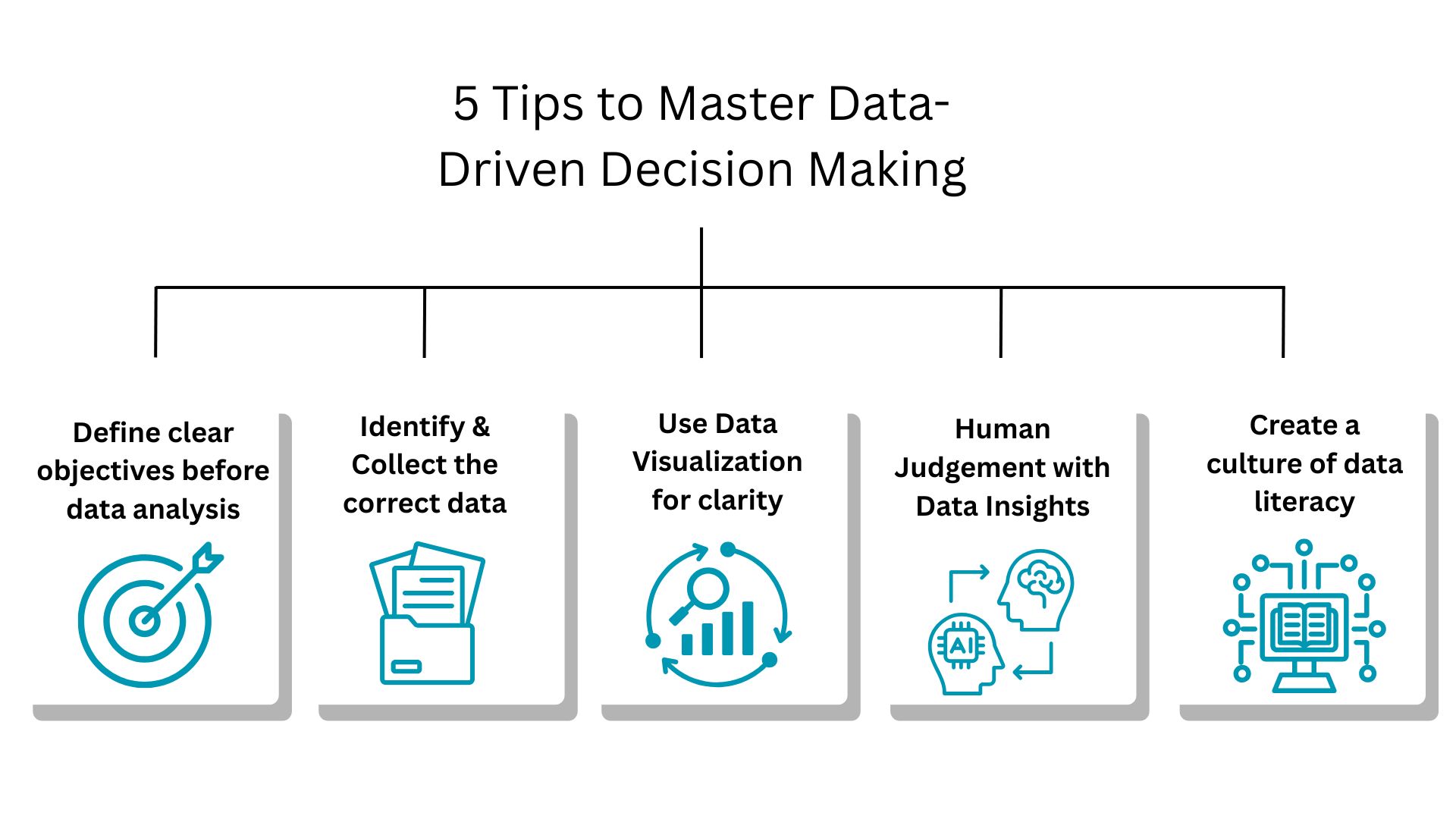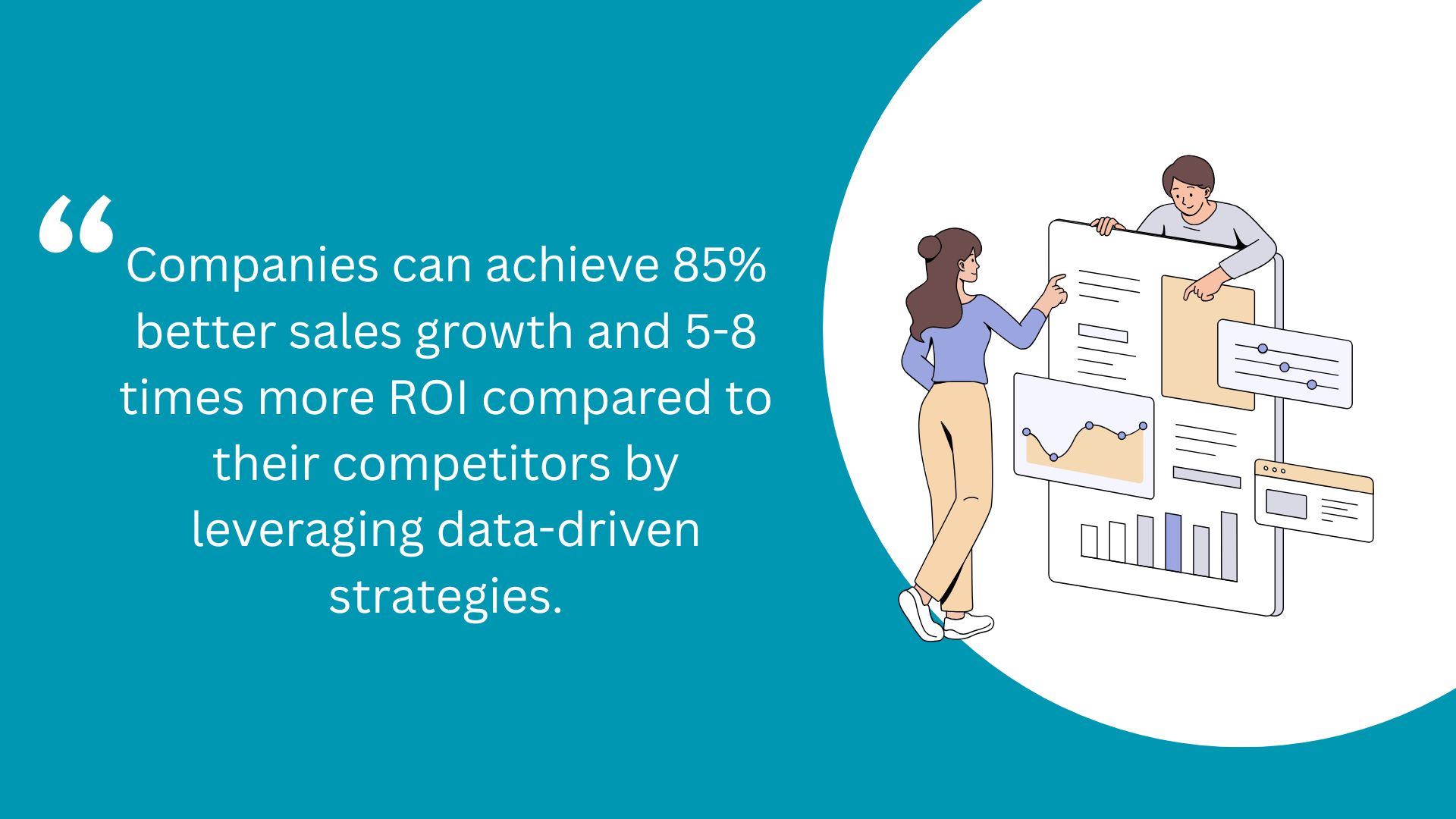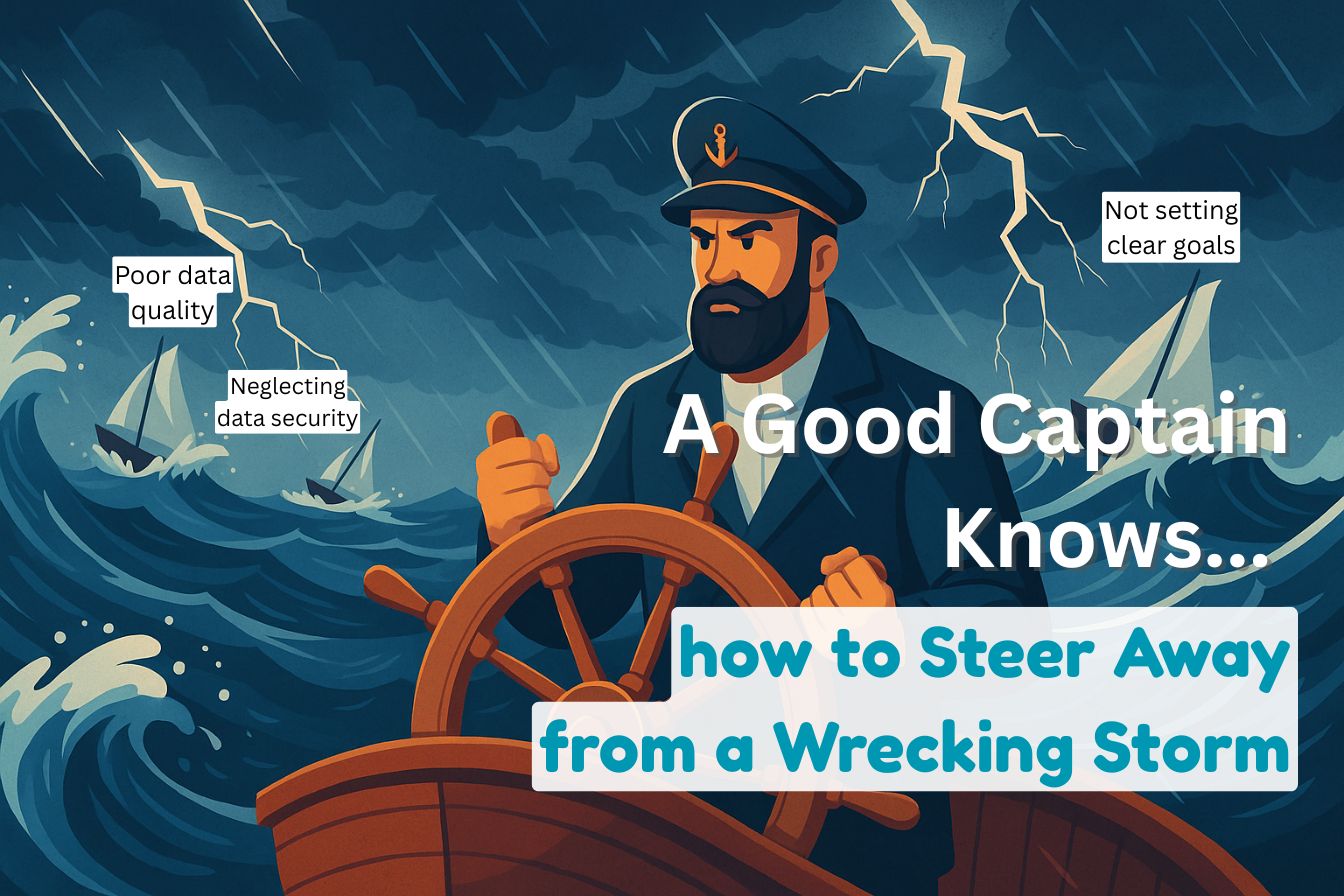Saramsh Gautam on Sep 08, 2025
Reading Time: 10 Min
Picture yourself steering a ship through dense fog without a compass. You might move forward, but the risk of drifting off course is high. That’s precisely what decision-making without data looks like in today’s fast-moving business landscape.
Markets shift overnight, customer expectations evolve in real time, and competitors are armed with powerful analytics. In this environment, relying on instinct alone may prove to be a high-stakes poker game.
According to a PwC survey, data-driven organizations are three times more likely to make faster, more confident decisions than those relying on gut feel, especially when you spend a lump sum budget on advertising, expecting to get the return on your money and sustain. From nimble startups to global enterprises, leaders now recognize that leveraging data is not just a competitive edge—it’s the foundation of sustainable success.
In this article, we’ll share five practical tips to help you transform raw data into meaningful insights, improve decision-making across your organization, and even see how offshoring can play a surprising role in the process.
What is Data-Driven Decision Making (DDDM)?
DDDM refers to the practice of basing business decisions on the analysis of data rather than relying solely on intuition, experience, or assumptions. At its core, it is the practice of making decisions based on facts, evidence, and measurable data.
For example, a retail store does not just guess which product will sell during the Black Friday sale. It looks at last year’s sales numbers, customer reviews, and market forecasts to prepare its inventory. In short, DDDM is about replacing “I think” with “I know.”

By combining these data with the purchase history, they develop a robust marketing and sales plan, ensuring higher sales and average revenue.
How Enterprise with Data-Driven Decision Making Creates Impact
Today’s highly competitive market demands precise product or service positioning and resource optimization. Additionally, the diverse and fragmented consumer base necessitates targeted strategies that can only be effectively informed and validated by data.
According to a PwC study, 64% of business executives believe that data-driven decision-making is essential to staying competitive, while only 24% of companies describe themselves as data-driven.
For startups, the stakes are even higher because, from time to time, a new startup emerges with a similar brand, target audience, and promises, creating even more competition and the risk of market saturation.
Here, you can learn from a few Big enterprises that have mastered data-driven decision-making.
1. Sharper Competitive Edge
Data enables enterprises to anticipate trends, customer shifts, and market risks before competitors.
Example: Netflix uses viewing data to determine which shows to produce, thereby reducing flop rates and enhancing subscriber loyalty.
2. Operational Efficiency
Real-time dashboards and predictive analytics identify bottlenecks, reduce waste, and optimize resource allocation.
Impact: Amazon boasts faster cycle times, lower costs, and higher ROI.
3. Personalized Customer Experience
With data, enterprises create tailored offers and seamless journeys, leading to deeper engagement.
Example: Amazon’s recommendation engine, powered by data, drives 35% of its total sales.
4. Informed Risk Management
Data analytics helps forecast supply chain disruptions, credit risks, or compliance issues.
Example: Insurance and Banking giants mitigate risks proactively rather than reactively.
5. Cultural Transformation
Data-driven decision-making creates a culture of transparency and accountability.
Teams align on facts, not opinions, which improves collaboration and confidence.
5 Tips to Master Data-Driven Decision Making in Organizational Affairs
Now let’s dive into the five powerful tips that can help you and your organization make more innovative and more effective decisions.

1. Define Clear Objectives before Data Analysis
Data without a defined purpose is just noise. Before collecting or analyzing anything, identify the specific problem you want to solve or the goal you want to achieve.
For example:
- Are you aiming to improve customer retention?
- Do you want to cut operational costs?
- Are you seeking to launch a new product?
Define the “why” before you chase the “what.” Otherwise, you will risk wasting time analyzing irrelevant data.
By setting measurable objectives, you will ensure that the data you gather is relevant and actionable, not overwhelming or distracting.
For instance, Amazon sets razor-sharp objectives for every team. Instead of “improve customer experience,” they might say, “reduce average delivery time from 2 days to 1.5 days.” That clear objective directs their data analysis toward shipping times, warehouse efficiency, and logistics partnerships.
2. Identify and Collect the Right Data (Quality over Quantity)
In the age of Big Data, it is tempting to think more is better. However, collecting an immense amount of data does not always lead to better decisions, but often raises complexity.
Focus on accuracy, relevance, and timeliness by collecting the following:
- Internal data (sales reports, customer feedback, employee performance metrics)
- External data (market trends, competitor analysis, industry benchmarks)
- Avoid the trap of data overload. Instead, prioritize the sources that directly impact your objectives.
- Identify and collect only what aligns with your objectives and keep it clean, accurate, and updated.
For example, Netflix does not track every single thing its users do. Instead, it zooms in on watch times, user ratings, and content completion rates to recommend shows.
3. Use Data Visualization for Clarity
Imagine someone handing you a 200-page report filled with numbers. Would you read it? Probably not.
That’s where data visualization comes in. By turning numbers into charts, dashboards, and infographics, you make insights instantly understandable. Clear visuals help stakeholders see trends, patterns, and anomalies at a glance, making it easier to communicate insights and get buy-in for your decisions.
Data visualization tools, such as Tableau, Power BI, or Google Data Studio, are convenient for transforming complex information into easy-to-understand and interactive charts, graphs, and dashboards.
|
Tool |
Benefits |
Usage |
|
Tableau |
Intuitive drag-and-drop, strong integrations, and advanced visuals |
Real-time dashboards for sales, marketing KPIs, and executive reporting |
|
Power BI |
Seamless with the Microsoft ecosystem, cost-effective, and AI-powered insights |
Enterprise reporting, finance tracking, and cross-department collaboration |
|
Google Data Studio (Looker Studio) |
Free to use, integrates with the Google ecosystem, and easy sharing via the cloud |
Marketing analytics, website traffic, and campaign monitoring |
|
Grafana |
Open-source, highly customizable, supports multiple databases (Prometheus, InfluxDB) |
Real-time monitoring of servers, IoT devices, and DevOps infrastructure |
|
Qlik Sense |
Associative data modeling, strong predictive analytics, interactive visuals |
Supply chain optimization, customer insights, and operational efficiency |
During the COVID-19 pandemic, Johns Hopkins University created a real-time dashboard tracking global cases. Millions relied on that clear visualization to make decisions, from government setting policies to individuals deciding whether to travel.
4. Combine Human Judgment with Data Insights
Making a decision based on data observations does not necessarily replace human insights, but it integrates data with human input to make a more informed decision. Numbers can highlight trends and probabilities, but they cannot always capture context, ethics, or creativity. The best organizations strike a balance between quantitative insights and qualitative wisdom.
Gartner predicts that by 2030, 80% of business decisions will be made by algorithms; however, human input will play a crucial role in guiding the “why” and “how.”
For example, a predictive model may suggest cutting a product because sales are down. Still, human leaders may consider factors such as brand loyalty or long-term strategy before making that decision.
Trust the data, but also trust your experience, empathy, and vision.
5. Create a Culture of Data Literacy
The final tip is the most powerful: build a culture where everyone understands and values data. It is not enough for the CEO or data analysts to use insights. Data-driven decision-making succeeds only if your team knows how to effectively use and interpret data.
Everyone from content production and marketing teams to HR manager should know how to read and apply data in their daily work. That’s why fostering data literacy across the organization is essential.
Ways to build data literacy:
- Offer training on analytics tools.
- Encourage evidence-based discussions in meetings.
- Incite curiosity and critical thinking about numbers.
- Reward employees who can use data to back up their ideas.
A data-literate culture ensures that insights flow at every level, not just in the C-suite, empowering employees to make smarter, faster, and more consistent decisions. When your entire team speaks the language of data, your organization moves faster, smarter, and with fewer costly mistakes.
However, the challenge lies in finding reliable expertise to manage data, tools, and churn, and produce comprehensible reports.
How to find Partners with Data-Driven Insights and Expertise?
One emerging strategy that many American companies are adopting is offshoring teams to support data-driven decision-making. Although located offshore, the team's sound in data management will not only reduce overhead expenses but also open access to a global talent pool at marginal costs.

Here is how to find a reliable partner to master data-driven decision making.
- Round-the-Clock Analysis: Identify a team that can work and report continuously, allowing businesses to process and analyze data more efficiently.
- Access to Specialized Talent: Countries such as Nepal and the Philippines have strong pools of data analysts, IT specialists, and researchers who can provide expertise on a large scale.
- Cost Efficiency: Outsourcing data-intensive tasks, such as data cleaning, report generation, or dashboard management, allows U.S. companies to reallocate resources toward strategic decision-making.
- Scalability: Finding an agile team enables rapid scaling of data operations, whether you are adding new markets, products, or customer segments.
Offshoring is not just about cutting expenses; it is about building a stronger, more agile foundation for data-driven growth and innovation.
Choosing a Proficient Offshoring Team
Selecting the right offshore team is just as important as deciding to offshore in the first place. Not every team will align with your organization’s vision, so you need to be strategic in your approach. Here’s how to make the best choice:
- Look for domain expertise: Choose a team with experience in your specific industry, such as finance, healthcare, retail, or technology. Industry knowledge ensures they understand the context of your data.
- Check technical proficiency: A proficient offshoring team should possess strong skills in tools such as Power BI, SQL, Python, R, or Tableau. Ask for proof of past projects.
- Evaluate communication skills: Data only becomes valuable when it is communicated well. Pick a team that can explain complex insights in clear, simple terms.
- Cultural alignment matters: Look for a team that shares your work ethic, professionalism, and values. Smooth collaboration depends on more than just technical skills.
- Test reliability and security: Data security is non-negotiable. Ensure your offshore partner follows international data protection standards (like GDPR or HIPAA, if relevant).
- Seek scalability: A good offshoring team should be able to scale with your growing data needs without compromising quality.
- Check references and case studies: Ask for client feedback or success stories that demonstrate their ability to deliver reliable results in the past.
In short, the best offshore partners act not as vendors but as extensions of your in-house team. They collaborate, innovate, and keep your organizational goals in focus while handling the technical side of DDDM.
Conclusion
By setting clear goals, focusing on the correct data, visualizing insights from the foundation, blending analytics with human wisdom, and fostering a culture of data literacy, business leaders can move with confidence rather than relying on guesswork.
Ultimately, effective organizational decisions emerge when data, people, and global partnerships collaborate. With the right tools and team, your data becomes more than just numbers – it becomes a clear path to more brilliant, faster, and more confident decisions, eventually shaping lasting success.
Offshoring brings a decisive advantage to this mix. By working with skilled offshore analysts, organizations gain access to expertise, cost efficiency, and continuous support.
Comments(0)
Your email address will not be published. Required fields are marked *
Recommended Posts
Unlock the Secret of Power BI to Empower Your Data Analysis
Turn Raw Data into Real-Time Intelligence with Power BI
How to Empower Your Web Development Project in 2025?
Empowering Your Web Build with the Right Strategy, Stack, and Global Talent Network
6 Tips for Selecting the Best Offshoring Team for IT Roles
Smart Scaling Starts Here: How to Choose Offshore Talent Without Compromise
RECOMMENDED TOPICS
TAGS
- offshoring
- outsourcing
- web development
- data analytics
- it support
- offshore
- insurance
- seo
- web security
- project management
- pms
- project management system
- agile methodology
- data
- data centric approach
- customer insight
- it infrastructure
- it sustainability
- cloud computing
- agentic ai
- artificial intelligence
- business process automation
- voice search optimization
- outsource
- global talent pool
- techical consulting
- power bi
- business intelligence
- digital marketing
- backoffice
- communication
- insurtech
- remote team
- it roles
- data engineering
- data engineer
- content development
- business development
- offshore talent
- legacy software
- data decision
- off
- test
About
Data Not Found

